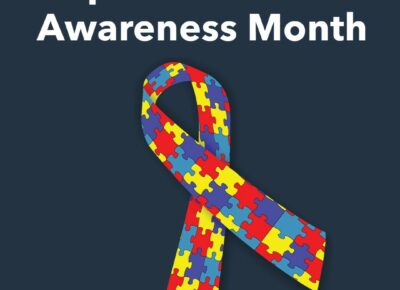Autism Awareness Month
As we recognize Autism Awareness Month, let’s review what Autism is.
Autism (Autism Spectrum Disorder)
What are autism spectrum disorder and what are the symptoms?
Autism spectrum disorder (ASDs) are a group of related brain-based disorders that affect a child’s behavior, social, and communication skills. It is estimated that Autism Spectrum Disorder affected 1 in 59 children. Autism spectrum disorder is a lifelong condition with no known cure. However, children with ASD can progress developmentally and learn new skills. Some children may improve so much that they no longer meet the criteria for ASD, although milder symptoms may often persist.
Symptoms
No 2 children with Autism have the exact same symptoms, but the criteria are somewhat standardized. The number of symptoms and how severe they are can vary greatly. The following are examples of how a child with ASD may act:
Social differences
- Doesn’t snuggle when picked up, but arches back instead
- Doesn’t keep eye contact or makes very little eye contact
- Doesn’t respond to parent’s smile or other facial expressions
- Doesn’t look at objects or events parents are looking at or pointing to
- Doesn’t point to objects or events to get parents to look at them
- Doesn’t bring objects to show to parents just to share his interest
- Doesn’t often have appropriate facial expressions
- Unable to perceive what others might be thinking or feeling by looking at their facial expressions
- Doesn’t show concern (empathy) for others
- Unable to make friends
Communication differences
- Doesn’t say single words by 15 months or 2-word phrases by 24 months
- Repeats exactly what others say without understanding its meaning (parroting or echolalia)
- Doesn’t respond to name being called, but does respond to other sounds (like a car horn or a cat’s meow)
- Refers to self as “you” and others as “I” (pronominal reversal)
- Often doesn’t seem to want to communicate
- Doesn’t start or can’t continue a conversation
- Doesn’t use toys or other objects to represent people or real life in pretend play
- May have a good rote memory, especially for numbers, songs, TV jingles, or a specific topic
- Loses language milestones, usually between the ages of 15 to 24 months in a few children (regression)
Behavioral differences (stereotypic, repetitive, and restrictive patterns)
- Rocks, spins, sways, twirls fingers, or flaps hands (stereotypic behavior)
- Likes routines, order, and rituals
- Obsessed with a few activities, doing them repeatedly during the day
- Plays with parts of toys instead of the whole toy (for example, spinning the wheels of a toy truck)
- May have splinter skills, such as the ability to read at an early age, but often without understanding what it means
- Doesn’t cry if in pain or seem to have any fear
- May be very sensitive or not sensitive at all to smells, sounds, lights, textures, and touch
- Unusual use of vision or gaze—looks at objects from unusual angles
- May have unusual or intense but narrow interests
Early signs of autism spectrum disorders
Many children with ASD may show developmental differences throughout their infancy, especially in social and language skills. Because they usually sit, crawl, and walk on time, these more subtle differences often go unnoticed.
Social skills. A child with ASD may have:
- Not smiled back to you or smiled less often or less enthusiastically than you expected.
- Not cuddled like other children.
- Not made as much eye contact with others.
- Not responded to her name being called.
- Seemed to tune others out. At other times, she may have seemed to hear environmental sounds, even very faint ones, perfectly well. This was probably confusing and may have caused you to worry about a hearing problem.
Language delays. All children with autism show significant language delays. Some children will seem to have met language milestones during the toddler years, but use of language may be abnormal.
Regression in developmental milestones. About 25% of children will seem to have normal development until about 18 months, after which they will gradually or suddenly:
- Stop talking (if they had begun to say a few words).
- Stop waving goodbye.
- Stop turning their heads when their names are called.
- Withdraw into a shell and seem more distant and less interested in their surroundings.
Although all children with ASD will need developmental and educational services and most will need therapy and behavioral interventions, only certain children may need medicine. Medicine may be needed to control behaviors that could interfere with ASD interventions. Aggressive or disruptive behaviors can become a problem when they cause physical harm to others (or to the child himself) or when they prevent him from cooperating with therapists or teachers.
Parents are encouraged to learn as much as they can about all the different treatments available. Treatment should focus on supporting the child to succeed in the real world.
Source: www.healthychildren.org/english/health-issues/conditions/Autism/pages/autism-spectrum-disorder.aspx
